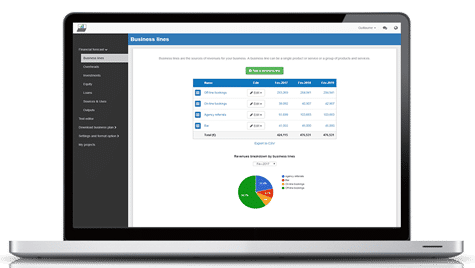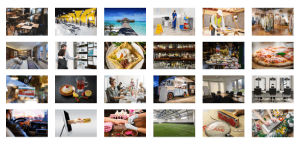How to create a financial forecast for a bottled water brand?
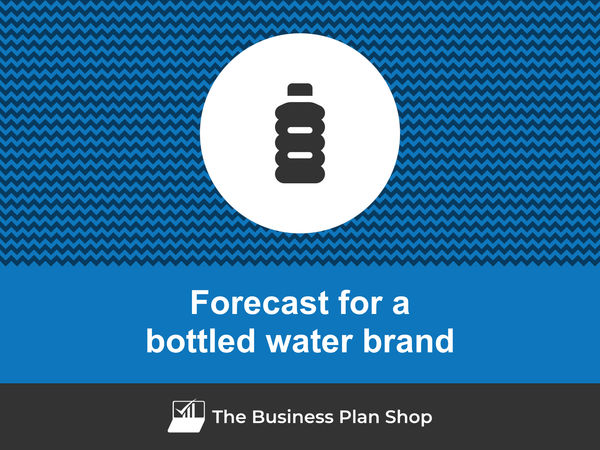
Developing and maintaining an up-to-date financial forecast for your bottled water brand is key in order to maintain visibility on your business’s future cash flows.
If you feel overwhelmed at the thought of putting together a bottled water brand financial forecast then don’t worry as this guide is here to help you.
We'll cover everything from: the main objectives of a financial forecast, the data you need to gather before starting, to the tables that compose it, and the tools that will help you create and maintain your forecast efficiently.
Let's get started!
Why create and maintain a financial forecast for a bottled water brand?
In order to prosper, your business needs to have visibility on what lies ahead and the right financial resources to grow. This is where having a financial forecast for your bottled water brand becomes handy.
Creating a bottled water brand financial forecast forces you to take stock of where your business stands and where you want it to go.
Once you have clarity on the destination, you will need to draw up a plan to get there and assess what it means in terms of future profitability and cash flows for your bottled water brand.
Having this clear plan in place will give you the confidence needed to move forward with your business’s development.
Having an up-to-date financial forecast for a bottled water brand is also useful if your trading environment worsens, as the forecast enables you to adjust to your new market conditions and anticipate any potential cash shortfall.
Finally, your bottled water brand's financial projections will also help you secure financing, as banks and investors alike will want to see accurate projections before agreeing to finance your business.
Need a solid financial forecast?
The Business Plan Shop does the maths for you. Simply enter your revenues, costs and investments. Click save and our online tool builds a three-way forecast for you instantly.
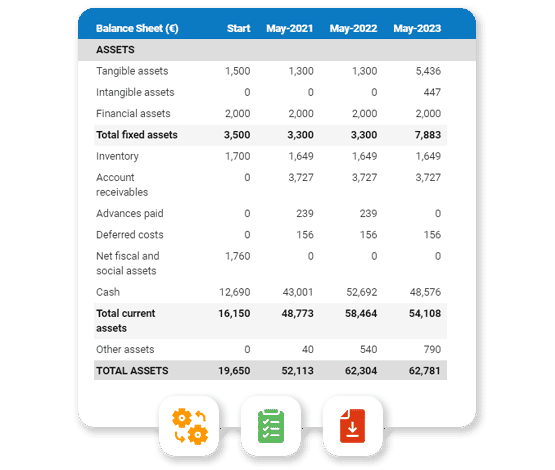
What information is used as input to build a bottled water brand financial forecast?
A bottled water brand's financial forecast is only as good as the inputs used to build it.
If you are creating (or updating) the forecast of an existing bottled water brand, then you mostly need your accounting information, key historical operating non-financial data, and your team’s input on what to expect for the coming years.
If you are building financial projections for a bottled water brand startup, you will need to have done your research and have a clear picture of your competitive environment and go-to-market strategy so that you can forecast sales accurately.
For a new venture, you will also need a precise list of the resources needed to keep the bottled water brand running on a day-to-day basis and a list of the equipment and expenditures required to start the business (more on that later).
Let's now take a closer look at the elements that make up your bottled water brand's financial forecast.
The sales forecast for a bottled water brand
From experience, it is usually best to start creating your bottled water brand financial forecast by your sales forecast.
To create an accurate sales forecast for your bottled water brand, you will have to rely on the data collected in your market research, or if you're running an existing bottled water brand, the historical data of the business, to estimate two key variables:
- The average price
- The number of monthly transactions
To get there, you will need to consider the following factors:
- Seasonal demand: The demand for bottled water may increase during the summer months when people are more likely to be outside and in need of hydration. This could lead to an increase in both average price and number of monthly transactions.
- Competition: The presence of other bottled water brands in the market may affect your average price and number of monthly transactions. If there is a lot of competition, you may need to lower your prices or increase marketing efforts to attract customers.
- Natural disasters: In the event of a natural disaster, such as a hurricane or drought, there may be an increase in demand for bottled water. This could result in a temporary increase in average price and number of monthly transactions.
- Health trends: If there is a shift towards healthier lifestyles and more people are choosing to drink bottled water instead of sugary drinks, this could lead to an increase in demand for your product and potentially an increase in average price.
- Packaging innovations: Innovative packaging, such as eco-friendly or sustainable options, may attract customers and allow you to charge a higher average price for your bottled water. This could also lead to an increase in number of monthly transactions as customers may be more inclined to purchase your product over others.
Once you have an idea of what your future sales will look like, it will be time to work on your overhead budget. Let’s see what this entails.
Need inspiration for your business plan?
The Business Plan Shop has dozens of business plan templates that you can use to get a clear idea of what a complete business plan looks like.
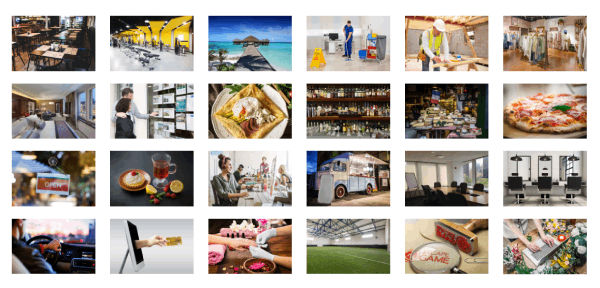
The operating expenses for a bottled water brand
The next step is to estimate the costs you’ll have to incur to operate your bottled water brand.
These will vary based on where your business is located, and its overall size (level of sales, personnel, etc.).
But your bottled water brand's operating expenses should normally include the following items:
- Staff costs: This includes salaries, wages, benefits, and any other related expenses for your employees such as training and recruitment costs.
- Marketing and advertising expenses: This includes costs for promoting your bottled water brand, such as social media ads, influencer partnerships, and print advertisements.
- Packaging materials: As a bottled water brand, you will need to purchase bottles, caps, labels, and other packaging materials to package your product.
- Production costs: This includes the cost of purchasing and maintaining equipment, as well as the cost of water, filtration, and bottling processes.
- Distribution expenses: This includes costs for shipping, transportation, and storage of your bottled water to retailers and distributors.
- Rent or lease expenses: If you have a physical storefront or warehouse, you will need to include the cost of rent or lease in your operating expenses.
- Utilities: This includes costs for electricity, water, and other utilities used in the production and operation of your bottled water brand.
- Accountancy fees: It is important to have a professional accountant to manage your financial records and prepare tax returns for your bottled water brand.
- Insurance costs: As a business owner, it is important to protect your assets and employees with insurance, such as liability insurance and workers' compensation insurance.
- Software licenses: You may need to purchase software licenses for programs such as accounting software, inventory management software, and customer relationship management (CRM) software.
- Banking fees: This includes fees for business bank accounts, credit card processing, and other financial transactions related to your bottled water brand.
- Legal fees: You may need to consult with a lawyer for legal advice or to draft contracts and agreements for your bottled water brand.
- Inventory costs: This includes the cost of purchasing and storing raw materials and finished products for your bottled water brand.
- Training and development: It is important to invest in the training and development of your employees to ensure the success of your bottled water brand.
- Professional fees: This includes fees for consulting services, marketing agencies, and other professional services used to support your bottled water brand.
This list is not exhaustive by any means, and will need to be tailored to your bottled water brand's specific circumstances.
What investments are needed to start or grow a bottled water brand?
Creating and expanding a bottled water brand also requires investments which you need to factor into your financial forecast.
Capital expenditures and initial working capital items for a bottled water brand could include elements such as:
- Bottling Equipment: This refers to the machinery and equipment needed to bottle and package the water. This can include bottling machines, filling machines, labeling machines, and capping machines.
- Water Treatment System: In order to ensure that the water is safe for consumption, a bottled water brand needs a water treatment system. This can include a filtration system, UV sterilization system, and ozone treatment system.
- Bottling Plant Facility: A facility is needed to house all the equipment and machinery for bottling the water. This can include the building itself, as well as any necessary renovations or construction costs.
- Delivery Vehicles: In order to transport the bottled water to retailers and customers, a bottled water brand may need to purchase delivery vehicles. This can include trucks, vans, and other vehicles specifically designed for transporting bottled water.
- Bottling Line Automation: Automation technology can increase efficiency and reduce labor costs in the bottling process. This can include automated bottle washing, filling, and capping systems.
Again, this list is not exhaustive and will need to be adjusted according to the circumstances of your bottled water brand.
Need a convincing business plan?
The Business Plan Shop makes it easy to create a financial forecast to assess the potential profitability of your projects, and write a business plan that’ll wow investors.
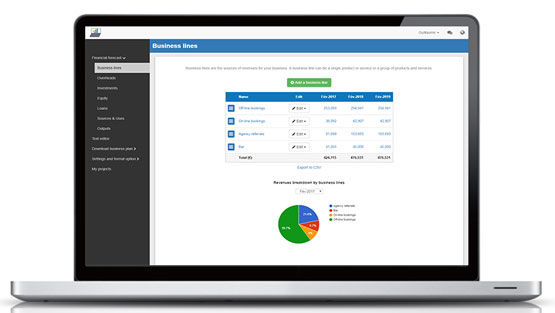
The financing plan of your bottled water brand
The next step in the creation of your financial forecast for your bottled water brand is to think about how you might finance your business.
You will have to assess how much capital will come from shareholders (equity) and how much can be secured through banks.
Bank loans will have to be modelled so that you can separate the interest expenses from the repayments of principal, and include all this data in your forecast.
Issuing share capital and obtaining a bank loan are two of the most common ways that entrepreneurs finance their businesses.
What tables compose the financial plan for a bottled water brand?
Now let's have a look at the main output tables of your bottled water brand's financial forecast.
The projected profit & loss statement
The projected profit & loss shows how profitable your bottled water brand is likely to be in the years to come.

For your bottled water brand to be financially viable, your projected P&L should ideally show:
- Sales growing above inflation (the higher the better)
- Profit margins which are stable or expanding (the higher the better)
- A net profit at the end of each financial year (the higher the better)
This is for established bottled water brands, there is some leniency for startups which will have numbers that will look a bit different than existing businesses.
The projected balance sheet
Your bottled water brand's projected balance sheet provides a snapshot of your business’s financial position at year-end.
It is composed of three types of elements: assets, liabilities and equity:
- Assets: represent what the business possesses including cash, equipment, and accounts receivable (money owed by clients).
- Liabilities: represent funds advanced to the business by lenders and other creditors. They include accounts payable (money owed to suppliers), taxes payable and loans from banks and financial institutions.
- Equity: is the combination of what has been invested by the business owners and the cumulative profits and losses generated by the business to date (which are called retained earnings). Equity is a proxy for the value of the owner's stake in the business.
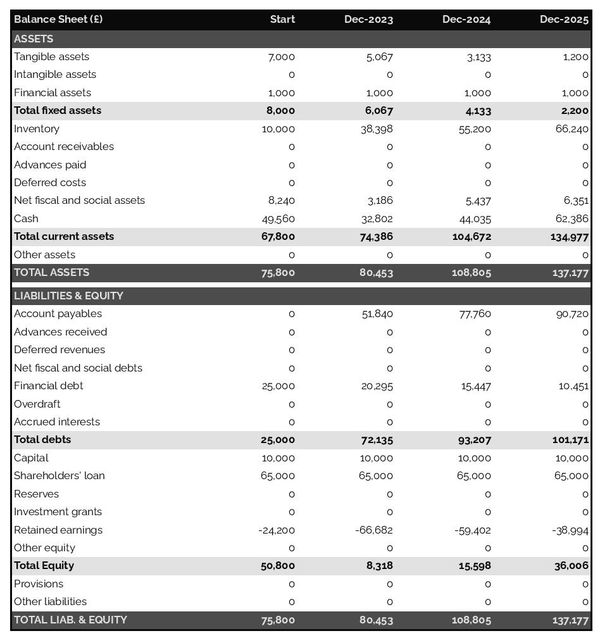
The cash flow projection
The cash flow forecast of your bottled water brand will show how much cash the business is expected to generate or consume over the next three to five years.

There are multiple ways of presenting a cash flow forecast but from experience, it is better to organise it by nature in order to clearly show these elements:
- Operating cash flow: how much cash is generated by the bottled water brand's operations
- Investing cash flow: what is the business investing to expand or maintain its equipment
- Financing cash flow: is the business raising additional funds or repaying financiers (debt repayment, dividends)
Your cash flow forecast is the most important element of your overall financial projection and that’s where you should focus your attention to ensure that your bottled water brand is adequately funded.
Note: if you are preparing a financial forecast in order to try to secure funding, you will need to include both a yearly and monthly cash flow forecast in your bottled water brand's financial plan.
Need a solid financial forecast?
The Business Plan Shop does the maths for you. Simply enter your revenues, costs and investments. Click save and our online tool builds a three-way forecast for you instantly.

Which tool should you use to create your bottled water brand's financial projections?
Building a bottled water brand financial forecast is not difficult provided that you use the right tool for the job. Let’s see what options are available below.
Using online financial forecasting software to build your bottled water brand's projections
The modern and easiest way is to use an online financial forecasting tool such as the one we offer at The Business Plan Shop.
There are several advantages to using specialised software:
- You can easily create your financial forecast by letting the software take care of the financial calculations for you without errors
- You have access to complete financial forecast templates
- You get a complete financial forecast ready to be sent to your bank or investors
- You can easily track your actual financial performance against your financial forecast, and recalibrate your forecast as the year goes by
- You can create scenarios to stress test your forecast's main assumptions
- You can easily update your forecast as time goes by to maintain visibility on future cash flows
- You have a friendly support team on standby to assist you when you are stuck
- It’s cost-efficient and much cheaper than using an accountant or consultant (see below)
If you are interested in this type of solution, you can try our projection software for free by signing up here.
Calling in a financial consultant or chartered accountant
Outsourcing the creation of your bottled water brand financial forecast is another possible solution.
This will cost more than using software as you can expect as your price will have to cover the accountant’s time, software cost, and profit margin.
Price can vary greatly based on the complexity of your business. For a small business, from experience, a simple three-year financial forecast (including a balance sheet, income statement, and cash flow statement) will start at around £700 or $1,000.
Bear in mind that this is for forecasts produced at a single point in time, updating or tracking your forecast against actuals will cost extra.
If you decide to outsource your forecasting:
- Make sure the professional has direct experience in your industry and is able to challenge your assumptions constructively.
- Steer away from consultants using sectorial ratios to build their client’s financial forecasts (these projections are worthless for a small business).
Why not use a spreadsheet such as Excel or Google Sheets to build your bottled water brand's financial forecast?
You and your financial partners need numbers you can trust. Unless you have studied finance or accounting, creating a trustworthy and error-free bottled water brand financial forecast on a spreadsheet is likely to prove challenging.
Financial modelling is very technical by nature and requires a solid grasp of accounting principles to be done without errors. This means that using spreadsheet software like Excel or Google Sheets to create accurate financial forecasts is out of reach for most business owners.
Creating forecasts in Excel is also inefficient nowadays:
- Software has advanced to the point where forecasting can be done much faster and more accurately than manually on a spreadsheet.
- With artificial intelligence, the software is capable of detecting mistakes and helping decision-making.
Spreadsheets are versatile tools but they are not tailor-made for reporting. Importing your bottled water brand's accounting data in Excel to track actual vs. forecast is incredibly manual and tedious (and so is keeping forecasts up to date). It is much faster to use dedicated financial planning tools like The Business Plan Shop which are built specially for this.
Need a convincing business plan?
The Business Plan Shop makes it easy to create a financial forecast to assess the potential profitability of your projects, and write a business plan that’ll wow investors.

Use our financial projection templates for inspiration
The Business Plan Shop has dozens of financial forecasting templates available.
Our examples contain both the financial forecast, and a written business plan which presents, in detail, the company, the team, the strategy, and the medium-term objectives.
Whether you are just starting out or already have your own bottled water brand, looking at our template is always a good way to get ideas on how to model financial items and what to write when creating a business plan to secure funding.
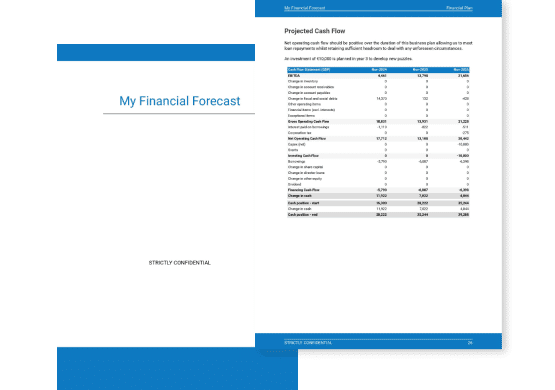
Takeaways
- A financial projection shows expected growth, profitability, and cash generation for your business over the next three to five years.
- Tracking actuals vs. forecast and keeping your financial forecast up-to-date is the only way to maintain visibility on future cash flows.
- Using financial forecasting software makes it easy to create and maintain up-to-date projections for your bottled water brand.
You have reached the end of our guide. We hope you now have a better understanding of how to create a financial forecast for a bottled water brand. Don't hesitate to contact our team if you have any questions or want to share your experience building forecasts!
Need inspiration for your business plan?
The Business Plan Shop has dozens of business plan templates that you can use to get a clear idea of what a complete business plan looks like.

Also on The Business Plan Shop
Know someone who runs or wants to start a bottled water brand? Share our financial projection guide with them!

